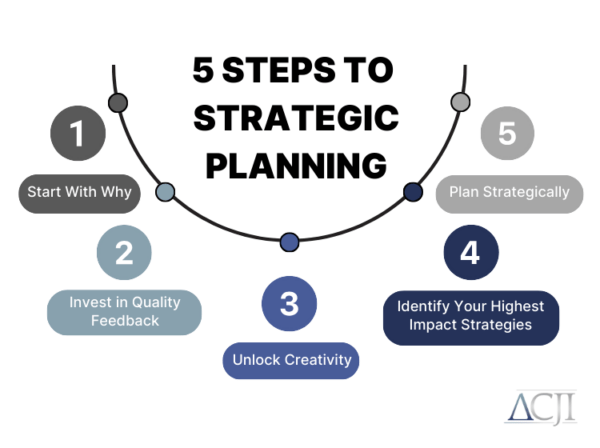5 Steps To Strategic Planning That Add Value
December 9th, 2024 – A planning event can boost your team’s motivation around shared goals. This article is one in a series of articles about Culture Catalysis, strategies that can accelerate culture change. To read the first article in the Culture Catalysis series, click here.

1. Start With Why
As Simon Sinek would say, people don’t buy what you do, they buy why you do it. Creating a common WHY for your team brings about connection and a common goal. When everyone knows that they are striving toward the same purpose they can act independently and autonomously, which are key ingredients of employee engagement.
It can also help to build a culture of understanding by helping people understand more deeply why they, and those around them, do the work they do. Planning that is out of alignment with our why and can cause confusion, disengagement, and organizational culture issues.
To get at the underlying reason why your staff does the work they do, ask the following questions, in order:
- Why do you do this work?
- Why is that important to you?
- What is it about you specifically that is well-suited to do this work?
- What need does it fill for you?
2. Invest In Quality Feedback
The most overlooked and often skipped step in strategic planning is taking the time to get feedback about strengths, gaps, and necessary improvements. Too many strategic planning sessions happen inside meeting rooms with the same people year after year and can suffer from group think.
Because our work is so important to us, and we see staff working hard, it can be difficult to diagnose where things break down, are inefficient, or in need of improvement. Take the time to consider who might see things differently and request feedback from both internal and external stakeholders to guide your planning session.

3. Unlock Creativity
As humans, we are creatures of habit and therefore at risk of getting stuck in the status quo. Being future oriented and appreciative can help keep the focus on what is possible, what you want to grow and strengthen, which creates more energy.
It can be helpful to start with a visioning exercise that engages the creative side of your brain and helps you to think outside of the box. Some ideas for you:
- Ask the group to imagine what they would do if there were no limitations.
- How would their work change if they had all of the resources, staff, and support needed to get the job done?
By considering your agency’s ideal state, you can unlock ideas and creative solutions to maximize your efforts. Unlike a traditional gap analysis which can suck us down a problem-solving rabbit hole, when you start from a place of creativity, you unlock possibilities and ideas that may not present themselves otherwise. These types of exercises can also build trust on your team and spark commitment among team members and to the deliverables.

4. Identify Your Highest Impact Strategies
Now that you have your creative juices flowing, review the results from the feedback you received about where you should focus your energy. Have your team list things that they both need and want to accomplish. At this stage, all ideas are good ideas, and you should engage in a brainstorming session that is as inclusive as possible.
Once you have a good list, condense the items listed into themes or groups. Then, consider the impact that each theme or group will have on your work, agency, and customers.
If you were able to work on this group of tasks, how much would it matter to you? Your staff? Your customers?
Then consider the feasibility of each theme or group.
- How possible is it to complete this grouping of tasks?
- Are there any possible barriers or just a few?
For each theme or group, provide a rating score for both impact and feasibility as well as an overall score for that area.
5. Plan Strategically
Once you have rated each theme or group as it relates to impact and feasibility, identify the top 2-3 areas that you want your team to focus on. This is the time to stretch one another and ask, what can you try? It’s also a time to hold one another accountable.

While you are together with your team, choose someone to act as an ambassador for each group of tasks and identify the key players who need to be involved. While it can be tempting to end your time together here, you can have a larger impact by setting the first three months of deadlines related to that group of tasks and schedule a follow up meeting where everyone can come back together and report out on those deliverables. While the ambassador and their team may be meeting more regularly, your team should come together to review progress at least quarterly. Chances are, changes will be made, and this iterative planning cycle is how strategic planning becomes strategic doing.
If you are a leader in need of strategic planning assistance, or for more ideas and activities related to strategic planning, contact us to learn more about how our team of expert facilitators can help.




